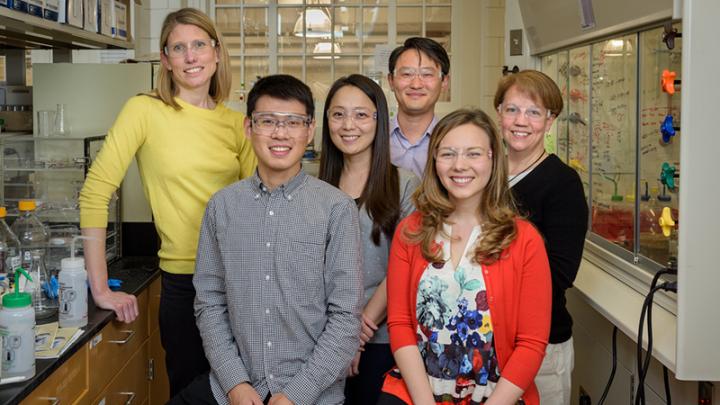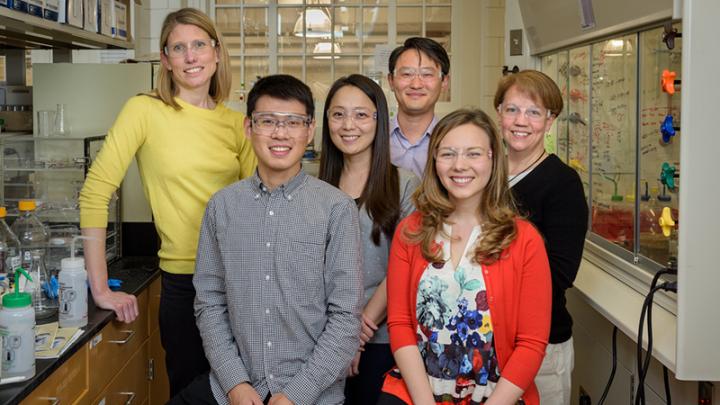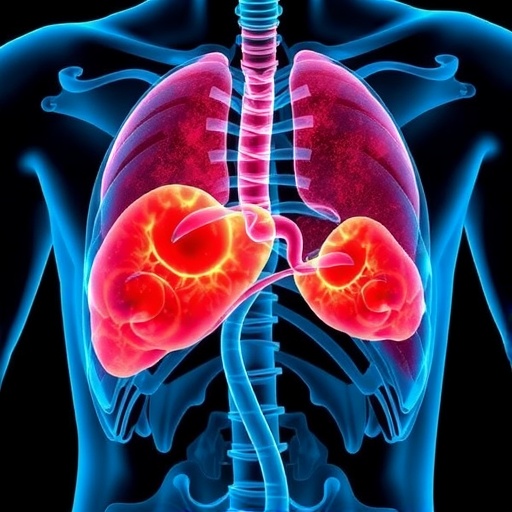
Credit: Evan Krape/ University of Delaware
You have three to five pounds of bacteria living in and on your body right now. That's some 38 trillion bacteria, researchers estimate. Your immune system has to manage all of them, sorting out the good from the bad bugs.
"We have an amazing immune system to keep that all in check, and then to deal with pathogenic bacteria," says Catherine Leimkuhler Grimes, assistant professor of chemistry and biochemistry at the University of Delaware. "It's fantastic when the system works, but also horrific when it doesn't."
When a beneficial bacterium is mistakenly identified as a harmful one, the immune system's attack can trigger chronic inflammatory diseases such as asthma, Crohn's disease and other disorders. Why this misidentification occurs is a mystery, but Grimes and her research team at the University of Delaware have invented a promising new method to literally help illuminate what happens. The advance is published in Nature Communications.
Labeling the cell 'jacket'
Now back to that three to five pounds of bacteria we carry around… Much of the weight comes from the bacteria's cell walls, or "jackets," as Grimes refers to them. Firm, yet flexible, they are composed of peptidoglycan — a mesh-like polymer made of protein (peptides) and sugar (glycan) molecules.
Bacteria routinely slough fragments of their peptidoglycan jacket. When the immune system misreads these fragments and attacks healthy tissue, chronic inflammatory diseases can arise. But scientists have not had much of an eye into that process, until now.
During the past four years, Grimes and her team have figured out how to label and light up the sugar backbone of the cell jacket — the first lab in the world to do so.
"We wanted to chemically make a new building block — like a Lego with triangles on top instead of circles — and then feed this material to the cell, which would use it to build its jacket without affecting anything else," Grimes explained. "Once the label was incorporated, we figured we could put 'flashlights' on it, which would help us to visualize the cell fragments and begin to identify immunostimulatory environments."
No one had ever labeled the glycan like this inside bacteria before, Grimes said, noting that the approach comes from the relatively new field of bioorthogonal chemistry, in which chemical reactions are done in a living system without interfering with that system's natural processes. She continues to marvel at how her students — both as individual scientists with unique strengths and as collaborators — managed to clear every hurdle they met, even when the prospects of success seemed a bit dim.
Team power
When the team hit a major roadblock early on, doctoral student Hai Liang saved the day, Grimes said. He had just read a recent manuscript from Christoph Mayer's laboratory at the University of Tuebingen, Germany, about how bacteria are natural recyclers.
"Bacteria are very 'green,'" Liang said. "They actually expend a lot of energy to create this polymer — peptidoglycan –a nd they want its building blocks back."
Liang told the team how Mayer's group had revealed two recycling enzymes, which Liang thought could potentially escort their chemically modified building block into the cell. But would the cell accept their slightly quirky building block with the triangles on top?
Doctoral student Kristen DeMeester developed a synthesis to install bioorthogonal functionality (the "triangles") — either an alkyne or azide — onto the sugar building blocks and tested the response from the cells. The bacteria liked it and were given their flashlights.
She also figured out how to make large quantities of sugars (glycan) as a feedstock.
"Even while going for a jog, I would think about how to make these sugars faster," said DeMeester. "Now I can do it in a week, and I teach undergrads how to do it." Her process for making these compounds, and the UD method itself, are now patent-pending.
Collaborators offer clearer view
To ensure their method was working, Grimes credits UD's Mass Spectrometry Facility for helping to tease out their peptidoglycan building blocks from the cell samples and find the fragment they were looking for.
Jeffrey Caplan, director of UD's Bio-Imaging Center, trained the team on the high-powered super-resolution microscope, with its 3-D imaging capability, to see the flashlights they put on the bacterial cell wall.
"The way Catherine and her team were directly labeling what they wanted to see, with nearly 100 percent specificity, was incredibly elegant and exciting," Caplan said. "We were actually seeing inside the cell walls, revealing individual molecules attached to the sugars."
"Without Jeff, our findings would never have happened," Grimes said. "Jeff put the glasses on for us."
But how do these labeled fragments affect the immune system? Enter collaborator Michelle Parent, associate professor of medical laboratory sciences at UD, and doctoral student Ching-Wen (Sandy) Hou, who works with macrophages — cells that find and eat foreign bodies.
When you grow human cells, you don't want anything dirty around. But a dirty incubator is exactly what Hou needed and used for culturing E. coli. After treating these cells with macrophages, she looked under the microscope and could see fragments of bacteria inside the macrophage, along with chunks of peptidoglycan.
"We're hoping to see which fragment activates the immune response in the future," Hou said.
The new UD method already is attracting new collaborators to the Grimes lab. A study with researchers at the University of Massachusetts Amherst focuses on Mycobacteria tuberculosis, which causes tuberculosis, while Helicobacter pylori, the bacterium that causes stomach cancer, is the target of a joint effort with the Fred Hutchinson Cancer Research Center in Seattle.
A dream team
To say that Grimes is proud of her research team would be an understatement.
"To see these graduate students work together so seamlessly and not let their egos get in the way–that's fantastic," Grimes said. "My colleagues at other universities ask, how did you get your students to work so well together? I think this was the best collaboration I've ever experienced."
Making a positive difference, through science, for people around the globe who suffer from chronic inflammatory diseases is her team's ultimate aim, Grimes said. Finding better therapies and potential cures will take brainpower, tenacity and hard work. And that's not all.
If you visit Grimes' office at UD, you're likely to see her lab's annual T-shirts hanging on the wall. Emblazoned across the back of the 2015 model is a line her lab lives by: "Trust your gut."
###
The project was supported by the National Institutes of Health-National Institute of General Medical Sciences through the Delaware COBRE and INBRE programs. Grimes also is a Pew Biomedical Scholar and a Cottrell Scholar.
Media Contact
Peter Bothum
[email protected]
302-831-1418
@UDResearch
http://www.udel.edu
############
Story Source: Materials provided by Scienmag





